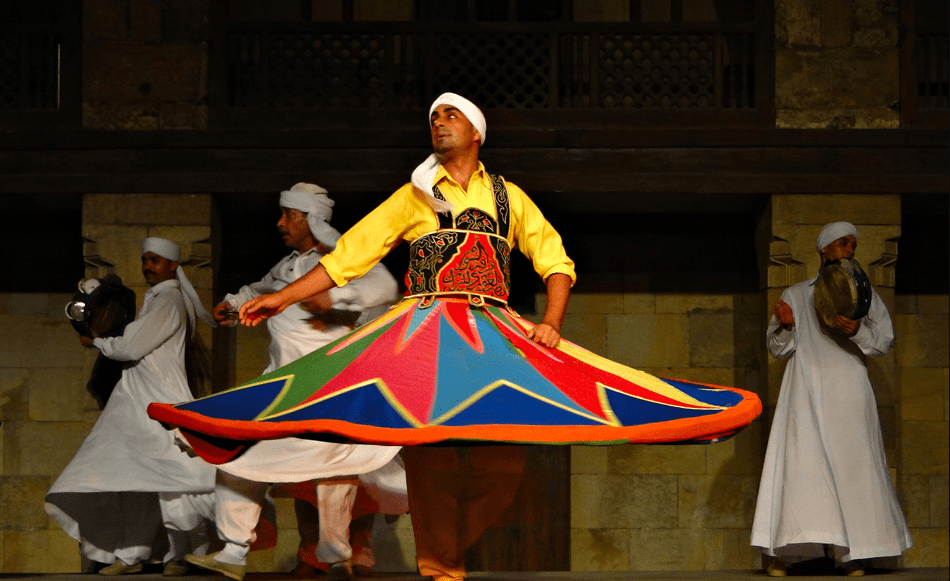From Beirut to Saudi Arabia, traditional Arab folk dances have long been a vibrant expression of culture, pride, and unity. Each region has developed its own unique style, and while these dances often get lumped together in the public imagination, each one tells its own distinct story.
Whether through the stomps of Dabke or the swirling skirts of Tanoura, these dances connect people to their past while adapting to modern times. Let’s take a closer look at a few of these iconic dances and how they continue to evolve today.
1. Dabke: Unity and Strength in Lebanon, Palestine, Syria, and Jordan
In Lebanon, Palestine, Syria, and Jordan, Dabke is a statement of unity. Originally, it was performed as a practical way to secure roofs and tents, but over time, it became a staple at weddings and community events.
Dancers hold hands and form a line, moving in sync with the beat of the tabl and mijwiz. The stomps aren’t just part of the routine—they represent strength and a deep connection to the community. Because of that, Dabke serves as a reminder of the power of togetherness, showing that even in tough times, people can come together and move forward as one.
2. Belly Dancing: Elegance and Expression in Egypt
Moving from the collective energy of Dabke, belly dance brings a more individual and intimate form of expression. With origins that trace back to ancient rituals, belly dance was once part of spiritual practices, particularly in fertility and nature celebrations.
Over time, it evolved into the glamorous art form we recognize today—an essential feature of Egyptian cinema and a beloved performance at weddings across the Arab world.
Unlike Dabke’s group dynamic, belly dance is all about controlled isolations. The dancer’s movements, often centered around the hips, stomach, and chest, are both graceful and powerful. This dance celebrates personal strength and elegance, offering a window into the dancer’s unique connection to the music and rhythm.
3. Ardah: Stories of Valor and Pride in Saudi Arabia
Over in Saudi Arabia, the Ardah stands as a living testament to the country’s history of valor and pride. Traditionally performed by two lines of men facing each other, each dancer holds a sword in one hand and claps to the beat with the other.
The rhythm of the drums, combined with the poetic chanting, tells stories of battles and victory. In recent years, the Ardah has been reimagined as a symbol of national identity, gaining popularity at national celebrations, such as the Janadriyah Festival. While its roots lie in the portrayal of military prowess, today’s Ardah tells stories of modern Saudi unity and strength.
4. Yowla: Precision and Agility in the UAE
In the United Arab Emirates, Yowla is a dance that captures both strength and grace. Derived from the ancient Ayyala dance, which highlighted the courage and skill of warriors, Yowla has grown into a performance that showcases precision and agility.
Performers, known as yawil, twirl imitation rifles or canes overhead, creating a spectacle of rhythm and dexterity. The dance is not only about physical prowess but also about showmanship, blending traditional chants with contemporary music.
Even though it was once a battlefield display, Yowla is now a performance art that symbolizes pride in Emirati culture, especially among the youth. The addition of modern rhythms and instruments makes it a dynamic, ever-growing tradition.
5. Tanoura: Spirituality and Tradition in Egypt
In Egypt, the Tanoura dance offers a mesmerizing display of spirituality and tradition. This folkloric dance traces its origins to Sufi practices and is heavily influenced by the idea of spiritual detachment and transcendence.
The dancer spins in circles for long periods, symbolizing the soul’s journey toward perfection. As the brightly colored skirt twirls around them, one hand reaches for the sky, while the other stays grounded, representing the balance between heaven and earth.
While Tanoura has its origins in religious rituals, its appeal has expanded. Today, it’s a popular feature at both spiritual events and cultural festivals, captivating audiences with its energy and spiritual depth.
Arab Dances Keep Culture and History Alive
No matter the dance, what’s clear is that traditional Arab dances do more than entertain—they preserve and honor culture, history, and community. Whether performed to celebrate love, unity, or spirituality, these dances keep the past alive in the present, connecting generations through rhythm, movement, and shared meaning.
So, whether you’re stomping in Dabke, spinning in Tanoura, or clapping along to the Ardah, each step is a celebration of the rich, living tradition that is Arab dance!
WE ALSO SAID: Don’t Miss…From Wedding Mirrors To Dance Bubbles: Elevate Your Arab Wedding With These 5 Creative Twists



